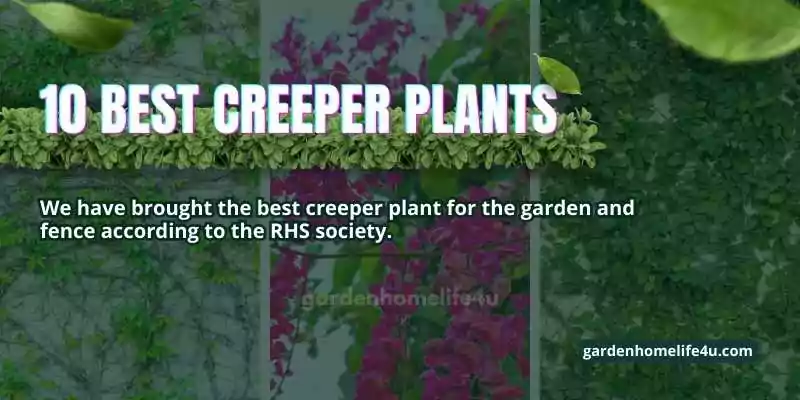Within the confines of your garden, where nature’s canvas unfolds, lies the fascinating world of creeper plants—a symphony of climbing wonders that bestow both privacy and beauty upon your outdoor sanctuary. We shall explore the fact that celebrates the dual magic of creeper plants, where they become the guardians of privacy, shielding your garden oasis from prying eyes, while simultaneously adorning your fence with a rich tapestry of lush foliage and vibrant blooms.
Imagine a garden where the fence becomes a living canvas, draped in verdant green and splashes of colors, creating an immersive and private retreat for you to revel in nature’s embrace. “Best Creeper Plants for Fence” unveils a handpicked selection of climbing wonders, each selected for its ability to not only add a touch of beauty but also serve as a natural barrier to protect your garden sanctuary.
In our collection of best creeper plants, you’ll discover a diverse array of options, from fast-growing climbers that provide instant privacy to delicate vines that infuse charm and elegance into your fence. These climbing wonders can easily cover vertical surfaces, creating an alluring backdrop for your garden’s diverse landscape.
The guide delves into the diverse world of creeper plants, showcasing species that bloom with resplendent flowers, bear delicious fruits, or offer year-round foliage to ensure your garden fence remains a vision of beauty in every season.
Moreover, the practical benefits of creeper plants extend beyond their aesthetic allure. These green guardians help mitigate noise, reduce wind impact, and create a microclimate that fosters biodiversity within your garden space.
So, whether you seek to transform your fence into a lush green wall or wish to create an outdoor sanctuary shielded from the outside world, “Best Creeper Plants for Fence – Privacy and Beauty in Your Garden” invites you to explore the wonders of climbing plants.
We already have some resources for garden fences ideas that may find useful, why not add some best creeper plants for your garden fences and pergolas to add a dab of color and texture to your garden design? Or you just want to cover the dull wall and increase security and privacy.
Climbing creeper plants can usually increase surface area, especially in a small garden for all sorts of applications. This may include flowers, just leafy foliage cover, or even fruits or vegetables. Before you start the process of buying a climbing plant there are a few important questions that need that needs to be answered by a certain calling plan. it all depends on how much work you are willing to put in to make certain climber plants a success. There is no such thing as no maintenance plants, all do require but some more than others, and they all have their unique set of challenges. To be more specific, there are climbers which need pruning multiple times a year, and given that you may need extra equipment such as ladders and support, etc for pruning and cutting, it might be worth finding out in detail what is the requirement and how would you fulfill it. Some key questions need answering
Garden Fence Creepers – A slow grower or fast?
This is a real trade-off and shows the pros and cons of choosing speed versus maintenance analysis. Of course, everyone wants something that will grow in two days, however, they will require a great amount of work and maintenance. On the other hand, a slow grower might take many years to fill up the desired area but not much pruning is required really. hence, it comes down again to your personal choice and circumstances. Wisteria is a very fast-growing climber and needs pruning twice a year and may reach inc a couple of years to the first-floor height, demanding the use of equipment and ladders, etc for pruning efforts. Hence it is quite a challenge to commit and you need to check your health and activity level before making such a commitment.
How big is this climber going to get?
When you get your starter climber plant from the shop it is in order of a few feet, but what we don’t know or realize is that this plant, given the right conditions, can grow up to 30 feet in every direction. Take notice of that, as climbers planted in conditions that they love can grow very fast and out of control in a few years. A good example is Rose Banksia which
is a real fast runner in good south-facing sunny conditions hence it is NOT a good choice for trellis application as it would outgrow and out weight the structure and can uproot itself in worse weather conditions.
Will your climber be in the sun or a shady place?
The common notion is spaces that are under the building shade or under a porch etc which do not get sun at all are generalled Shady places. This is generally true however if you got a patch of space right up north-facing that is also a very shady place. Putting up a climber in North facing area would result in undesired consequences such as your climber reaching out to mostly sunny and reachable areas such as neighbors’ walls. one example is some specie of Clematis which is generally a shade-loving plant but makes the wrong choice and the result after years of hard work would not be so great.
How does a Creeper climb and is any support needed?

Then there is this question of how the creeper actually climbs up. does it wrap around the poles, support, and trellis? or does it has a root that will cling to the wall and structure and damage it over the years? Last but not least, it could be the type that requires just tieing up. Wisteria for example climbs by looping around the structure or trellis or poles. these loops will become thicker over the year and quite heavy hence you need a strong structure to support them over many years of growth. If the creeper climbs and clings using the roots or suckers then it can damage the walls and fences. According to RHS, IVY, a common clinger type, is unlikely to damage the walls in good condition. However, it is recommended that you use the trellis for ivy climb. It is a marvelous choice as a wildlife
support creeper. Boston IVY is a good example where it is not as fast-growing as common IVY and is less likely to damage the walls and structures. Also, it would make sense not to use wall-clinging creepers if your walls are damaged and require frequent access.
Hardy variegated kiwi is easy to look-after creeper which will not require too much pruning and has lovely foliage.
No matter what your reason is, the best creeper plant will fulfill all your needs with glamour. They are ideal for every type of garden, especially small ones as they do not cover much ground space, add height, and create a more natural closure than any fancy or decorative garden fences.
However, you need to do some preparations in advance for climbing. You will need a trellis, solid climbing panels, ropes, hinges, or metal rods to support your climbers. You can’t do it afterward as it might upset the roots of the best creeper plants.
You also need to decide whether you want perennial or annual climbers. Perennial creepers might take 1-2 years to get fully grown and spread but they will bloom every year and might become the statement of your garden fence.
On the other hand, annuals and biennials are fast-growing creeper plants but only have a life cycle of 1-2 years which means more hard work and a change of scenery. Besides that, you also need to consider the location of your house and the wall where you want to grow the best creeper plants to cover your garden fence and pergolas.
You see, sun-loving climbers can’t grow in shade and vice-versa. So you have to be very careful while choosing your best creeper plants or you will waste both your time and efforts. We have prepared a list of the 10 best creeper plants and further divided them based on sun-loving climbers and shade-loving climbers. You can find some specimens here.
Types Of Best Creeper Plants
There are several varieties of the creeper plants such as flowering, fruity, and unusual vines with some use. However, you should know the main types of creeper plants before you choose one for your garden fence, walls, archway, and pergola.
You can divide creeper plants into two main categories as follows:
1. Evergreen Creepers
Evergreen creeper plants are those which remain green throughout the year. They do not shed leaves and some bloom throughout the year or most of the season. They look perfect for garden fencing and pergolas.
Evergreen creeper plants can be both perennials and annuals. Thus, their growth ratio and life cycle depend on them. Clematis Armandii is one of the popular evergreen climbers.
2. Deciduous Creepers
Deciduous creepers are those plants that shed leaves in winter but they are still worth having because they provide a vast number of colors, textures, and foliage. These creeper plants shed their leaves in winter but when they bloom they give spectacular spring colors that are very rare to find in evergreen creeper plants. Dutchman’s pipe, Climbing Hydrangea, and Wisteria are some of the popular deciduous creeper plants and they are worth the wait.
How To Choose The Climber Or Creepers Plant For Your Garden?
Once you make up your mind about the evergreen and deciduous creeper plants. Now, it is time to choose the best creeper plant for your garden. There are certain factors that you need to consider to buy the best creeper plant for your garden fence, archway, or pergolas.
A few factors that you need your attention to are:
1. Aspect- Be careful of the location of the climber, sun-loving creepers don’t thrive in shade and shade-loving climbers will get dull and gloomy in the sun.
2. Size and height- consider the height and the spread of the creepers in mind before planting. Some spread widely and can cover the whole area but some need maintenance and care to climb. You need to carefully select the creeper plant according to the allocated location.
3. Hardiness- Some climbers have thick branches that can carry their weight and stand with little help but many creepers are very tender and need constant attention and focus to stand. Tender creepers are vulnerable to the sun and need a lot of water in the starting years.
4. Climbing habit- Some climbers are self-clinging and need very little guidance but others like wall shrubs require support via trellis, hooks, and ropes to cling to the wall or roof or they will fall on the floor.
10 Best Creeper Plants

We have brought the best creeper plant for the garden and fence according to the RHS society. We have divided this climber further into sun-loving and shade-loving creepers for you to choose accordingly.
l For a Sunny South Or West-Facing Wall
1. Trachelospermum – Also known as Star Jasmine native to eastern and southeastern Asia. It requires very little attention and guidance in the beginning. It is a self-clinging, twining climber plant. It blooms white color flowers with a sweet and spicy scent.
2. Campsis Radicans – it is also known as trumpet vine or trumpet creeper plant. It blooms in red, orange, and yellow colors with bluish-green foliage. This plant requires a lot of water to grow. It can grow up to 10 meters. If you have a damp place then Campsis Radicans is an ideal creeper plant for you to grow.
3. Solanum Cripsum ‘Glasnevin’ – This plant is native to Chile and Peru and that is why it is also known as the Chilean Potato vine. It is a semi-evergreen, Woody stemmed plant. It can grow up to 6 meters tall which makes it ideal for your garden fence. It blooms in spring and summer in lavender-purple hues.

4. Ceanothus – Commonly known as Californian Lilacs. It is an evergreen perennial creeper plant that can grow up to 6 to 8 meters. It is a wall shrub that can grow free-style or wall-clinging. It has dark green veined leaves with burgundy flowers and has a honey-like scent.
5. Coronilla Valentina – this tender creeper plant is an evergreen shrub and needs protection against winter. It has delicate foliage and bright yellow pea-shaped flowers that bloom from late winter to early spring. It has a rich sweet fragrance but it is quite a toxic plant so be careful while tending.
l For a Shady North Or East Facing Wall
1. Parthenocissus – It is a deciduous creeper plant that you can grow in damp and moist areas to protect soil erosion. It is also known as Virginia Creeper. It has dark green leaves with grapevine-colored berries that are loved by birds. It is an excellent garden fencing creeper plant.
2. Hydrangea Anomala subsp. Petiolaris AGM – Hydrangea is a symbol of grace, beauty, and gratitude. It has received the AGM award from RHS society as the best creeper plant. It has purplish bark with heart-shaped leaves. It blooms soft lavender and purple color flowers in a bunch. It is one of the best deciduous creeper plants for your garden fence, archways, and pergolas.
3. Akebia Quinata – This climber is commonly known as Chocolate Vine due to its five leaf-flowers in chocolate vine color. It is a wall shrub native to Japan, China, and Korea. It is a fruity creeper plant that can be used both as fruit and vegetable. It doesn’t require much water and thrives in Shade.

4. Garrya Elliptica ‘James Roof’ – James Roof is a beautiful winter-blooming evergreen shrub with silk leaf tassels. It is famous for its long silver catkins or tassels. It needs well-drained soil with full sun or dappled shade.
5. Rosa ‘Alberic Barbier’ – It is one of the smallest rose flower creeper plants with opulent creamy yellow color. It blooms in winter and you can train this plant into growing as you desire. It is a vigorous shrub that can grow up to 4 to 8 meters. It loves shade but it can also grow in sunlight with little care. Alberic Barbier is a semi-green best creeper plant.

